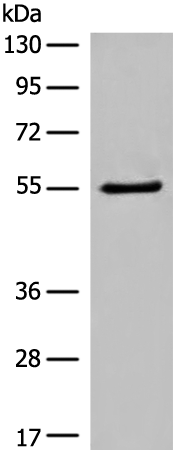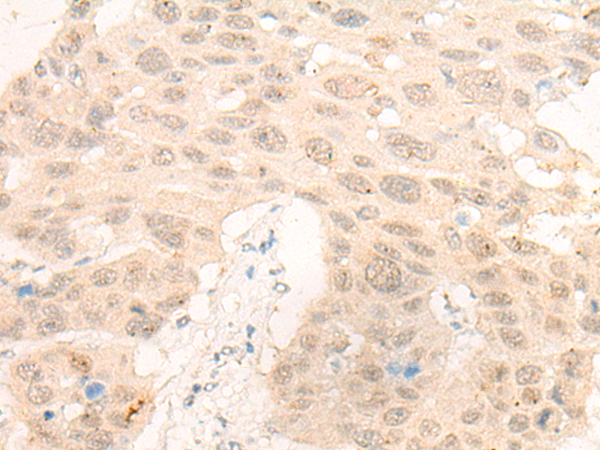


| WB | 咨询技术 | Human,Mouse,Rat |
| IF | 咨询技术 | Human,Mouse,Rat |
| IHC | 1/20-1/100 | Human,Mouse,Rat |
| ICC | 技术咨询 | Human,Mouse,Rat |
| FCM | 咨询技术 | Human,Mouse,Rat |
| Elisa | 1/5000-1/10000 | Human,Mouse,Rat |
| Aliases | IRT1; ARTD3; ADPRT3; ADPRTL2; ADPRTL3; PADPRT-3 |
| WB Predicted band size | 60 kDa |
| Host/Isotype | Rabbit IgG |
| Antibody Type | Primary antibody |
| Storage | Store at 4°C short term. Aliquot and store at -20°C long term. Avoid freeze/thaw cycles. |
| Species Reactivity | Human |
| Immunogen | Synthetic peptide of human PARP3 |
| Formulation | Purified antibody in PBS with 0.05% sodium azide and 50% glycerol. |
+ +
以下是3篇与PARP3抗体相关的文献摘要概览:
---
1. **文献名称**: *PARP3 is a promoter of chromosomal rearrangements and limits gene induction by taxol*
**作者**: Boehler, C. et al.
**摘要**: 该研究通过使用PARP3特异性抗体进行免疫沉淀和染色质分析,揭示PARP3在维持染色体稳定性中的双重作用:一方面促进DNA损伤诱导的染色体易位,另一方面通过抑制HDAC5调控基因表达,影响紫杉醇诱导的细胞死亡。
2. **文献名称**: *PARP3 controls TGFβ-mediated ROS production and genome stability in mesenchymal stromal cells*
**作者**: Liu, Q. et al.
**摘要**: 研究者利用PARP3敲除模型及相应抗体,证明PARP3通过调控TGFβ信号诱导的活性氧(ROS)生成,影响间充质干细胞的DNA修复能力和基因组稳定性,为靶向PARP3的癌症治疗提供依据。
3. **文献名称**: *Specificity of antibodies for pADPr and PARP3 in immunofluorescence assays*
**作者**: Haince, J.F. et al.
**摘要**: 该文献系统验证了多种PARP家族抗体(包括PARP3)在免疫荧光中的特异性,强调在检测PARylation修饰时需排除交叉反应,为PARP3功能研究中的抗体选择提供了方法学参考。
---
**备注**:若需获取全文或具体实验细节,建议通过PubMed或期刊数据库检索文献标题,部分研究可能涉及抗体货号或验证数据。
PARP3 (Poly(ADP-ribose) polymerase 3) is a member of the PARP protein family, which plays a critical role in DNA damage repair, genomic stability, and cellular stress responses. Unlike its well-characterized homologs PARP1 and PARP2. PARP3 exhibits distinct functional properties. It is a DNA-dependent ADP-ribosyltransferase involved in the repair of DNA single-strand breaks (SSBs) and double-strand breaks (DSBs), particularly through non-homologous end-joining (NHEJ) pathways. PARP3 also interacts with key DNA repair proteins, such as Ku70/Ku80. and modulates chromatin structure to facilitate repair processes.
PARP3 antibodies are essential tools for studying its expression, localization, and molecular interactions in various biological contexts. They are widely used in techniques like Western blotting, immunofluorescence, and immunohistochemistry to investigate PARP3's role in cancer, neurodegenerative diseases, and responses to genotoxic agents. Emerging research highlights PARP3's potential as a therapeutic target, especially in cancers with defective homologous recombination (HR) repair. Inhibitors targeting PARP3. often in combination with PARP1/2 inhibitors, are under exploration to enhance treatment efficacy.
Dysregulation of PARP3 has been linked to tumor progression, chemoresistance, and altered DNA damage signaling. Its expression levels may serve as a biomarker for patient stratification in therapies involving PARP inhibitors. However, the full scope of PARP3's biological functions and clinical relevance remains an active area of research, necessitating reliable antibodies for mechanistic and translational studies.
×